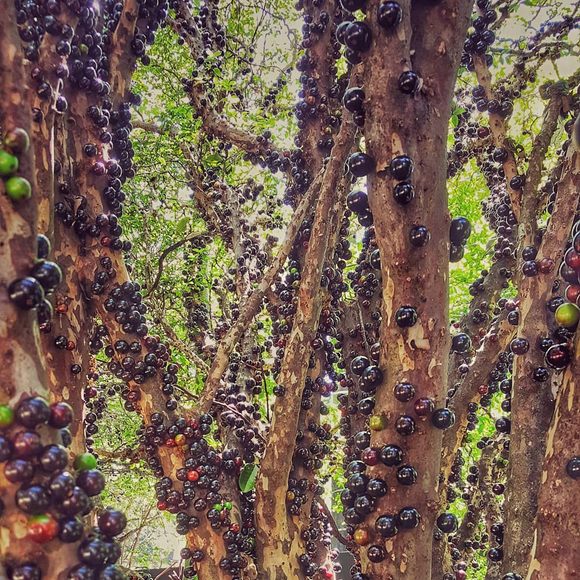Jaboticabas, at a glance, look almost exactly like grapes; in fact they look so grapelike that they even have the nickname “tree grapes.” But unlike grapes, these little violet fruits wind up and around tree trunks, sometimes overtaking the tree completely.
The jaboticaba tree is what’s known in the plant world as a cauliflory, meaning that its flowers and fruits grow directly out of its trunk. If you happen across one of these trees, it might seem as if it’s under attack by purple balls. The skin of these spheres is edible but with a harsh, herbal flavor from its high tannin content. Harvesters may use the skin medicinally (to treat coughing up blood, dysentery, or asthma), but most will discard it. The best way to eat jaboticaba fruit is by breaking a hole in the skin with your teeth and sucking out the white flesh inside.
Like grapes, there are many varieties of the fruit. One of the most common, known as red jaboticaba (although it is more of a violet color), tastes like blueberry yogurt. White jaboticabas taste like sour lychees, and Grimal jaboticabas taste like grape candy. But that’s just a small sample. There are countless other varieties. One thing they all seem to have in common is that they are bursting with flavor.
These fruits are immensely popular throughout their native Brazil, where they are most commonly eaten out of hand, but are also used to make jams and wine. They’re also a favorite fruit of gardeners in subtropical regions of the United States. Unfortunately, however, they ferment shortly after being picked, so the fruits are unlikely to show up in supermarkets outside their native range.
Written By
 Jared Rydelek
Jared Rydelek
Sources
- hort.purdue.edu/newcrop/morton/jaboticabas.html
- books.google.com/books?id=fC0-AQAAMAAJ&pg=PA1713&lpg=PA1713&dq=jaboticaba+horticulture&source=bl&ots=o2Vi2-TYiv&sig=3Q6MIyDcoS5iHwPl7qEt9Vzc7jQ&hl=en&sa=X&ved=0ahUKEwj6uc7pysnZAhWFylkKHXPSDRsQ6AEISjAF#v=onepage&q=jaboticaba%20horticulture&f=false
- books.google.com/books?id=eScsDwAAQBAJ&pg=PA237&dq=Myrciaria+aureana&hl=en&sa=X&ved=0ahUKEwiN7NjWvMvZAhXJct8KHZrqAv0Q6AEILDAB#v=onepage&q=Myrciaria%20aureana&f=false
- www.daleysfruit.com.au/fruit%20pages/jaboticaba.htm
- www.ncbi.nlm.nih.gov/pubmed/28544198
- www.botany.hawaii.edu/faculty/carr/myrt.htm
- www.britannica.com/plant/jaboticaba-Plinia
















